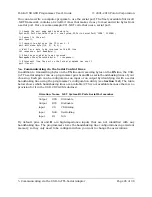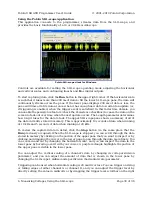
7. Troubleshooting
This section helps solve problems you might have using the Pololu USB AVR programmer.
If the computer fails to connect to the programmer:
• Make sure your programmer is connected to your computer via a USB A to mini-B
cable. If the programmer was previously working and has since stopped, try closing all
programs using the programmer (the configuration utility, the SLO-scope client, and the
AVR Studio ISP dialog), and cycle the power by unplugging it from your computer and
then reconnecting it.
• If you are in Windows, make sure you have installed the drivers the programmer
needs to operate.
describes how to install the drivers in Windows.
• Is the programmer’s green USB status LED on? This is the LED next to the USB mini-
B connector. If this LED is blinking, then your drivers are not properly installed.
• If you are in Windows, can you see your programmer listed in the Device Manager?
The Device Manager should show three devices: under “Pololu USB Devices” should
be “Pololu USB AVR Programmer”, and under “Ports (COM & LPT)” should be “Pololu
USB AVR Programmer Programming Port” and “Pololu USB AVR Programmer TTL Serial
Port” and there should be no error symbols on the icons representing these devices.
• If you are in Linux, check that
/dev/ttyACM0
and
/dev/ttyACM1
exist. If they do not,
see the section below.
• Your computer will only let one program at a time have a given COM port open. If you
are connected to your programmer’s programming port using another program, such
as a terminal or a second instance of AVR Studio, you will not be able to connect to
that same COM port with your programming software. Please make sure you do not
have any terminal programs connected to your programmer’s programming port. If you
have multiple versions of AVR Studio running, make sure that you have closed the ISP
programming dialogs in all of them. When the ISP dialog is open, that instance of AVR
Studio has an open connection to your programmer’s programming port.
• If you are using AVR Studio, try connecting to your programmer’s specific COM port
instead of selecting the “Auto” option, which attempts to locate the port automatically.
Some versions of AVR Studio have a bug that prevents it from automatically detecting
the programmer if the virtual COM port is too high.
If the programmer has problems connecting to the target AVR:
• The most common cause for this problem is an incorrect connection between your
programmer and your target device. If the ISP pins are misaligned between the
programmer and the target AVR, the two will not be able to communicate. Please make
sure that the ISP pins as numbered in
are correctly connected between your
AVR and your programmer (i.e. 1 goes to 1, 2 goes to 2, etc.).
• The target AVR must be powered for programming to work. Please make sure that
your target device has power and is turned on.
• If the target AVR is running at a voltage lower than 5 V, you may need to decrease
the minimum allowed target VDD setting using the configuration utility (
).
The default minimum allowed target VDD setting is too high to allow the programmer
to program at low voltages. Please note that you might need to take additional special
steps to safely program an AVR that is running off of a voltage below VUSB-0.5 V.
• Your programmer’s ISP frequency must be less than a quarter of your target AVR’s
clock frequency. If you are having trouble communicating with your target AVR, try
Pololu USB AVR Programmer User's Guide
© 2001–2010 Pololu Corporation
7. Troubleshooting
Page 32 of 36




































